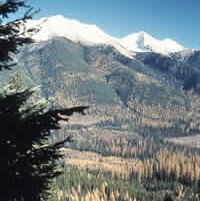 The Coram Experimental Forest (CEF) was established in 1933 on the Flathead National Forest in northwestern Montana. This forest represents the western larch (Larix occidentalis) forest type occurring in the upper Columbia River basin. Western larch trees regenerate best on exposed soil and full sun sites that are typical after fires or similar disturbances. Conservation of the western larch forest type is a priority for area land managers.
The Coram Experimental Forest (CEF) was established in 1933 on the Flathead National Forest in northwestern Montana. This forest represents the western larch (Larix occidentalis) forest type occurring in the upper Columbia River basin. Western larch trees regenerate best on exposed soil and full sun sites that are typical after fires or similar disturbances. Conservation of the western larch forest type is a priority for area land managers.
Although there are six forest types represented on the CEF, the majority of the forest is covered by western larch and Douglas-fir (Pseudotsuga menziesii), but Engelmann spruce/subalpine fir (Picea engelmannii/Abies lasiocarpa) forests occur on cool, moist sites at all but the lowest elevations.
Research and Resources -
Fire Behavior:
Predicting duff and woody fuel consumed by prescribed fire in the Northern Rocky Mountains
Fire Effects - Plants:
Establishment and growth of conifer regeneration following harvest and residue treatments in a western larch-Douglas-fir forest
Seedbed treatments influence seedling development in western larch forests
Site treatments influence development of a young mixed-species western larch stand
Fire Effects - Soils:
Effects of prescribed fire on soil nitrogen levels in a cut-over Douglas-fir/western larch forest
Effects of fire on nitrogen in forest floor horizons
Long-term soil changes from forest harvesting and residue management in the northern Rocky Mountains
Fire History:
Forest fire history in the Northern Rockies
Fire history of Coram Experimental Forest
Fire history of a western larch/Douglas-fir forest type in northwestern Montana
Vegetation structure in old-growth stands in the Coram Research Natural Area in northwestern Montana
Fuels Assessments & Monitoring:
Long-term effects on distribution of forest biomass following different harvesting levels in the Northern Rocky Mountains
Surface fuel litterfall and decomposition in the Northern Rocky Mountains, U.S.A.
Influence of harvesting and residues on fuels and fuel management
Smoke & Air Quality:
Fire and smoke in Montana forests